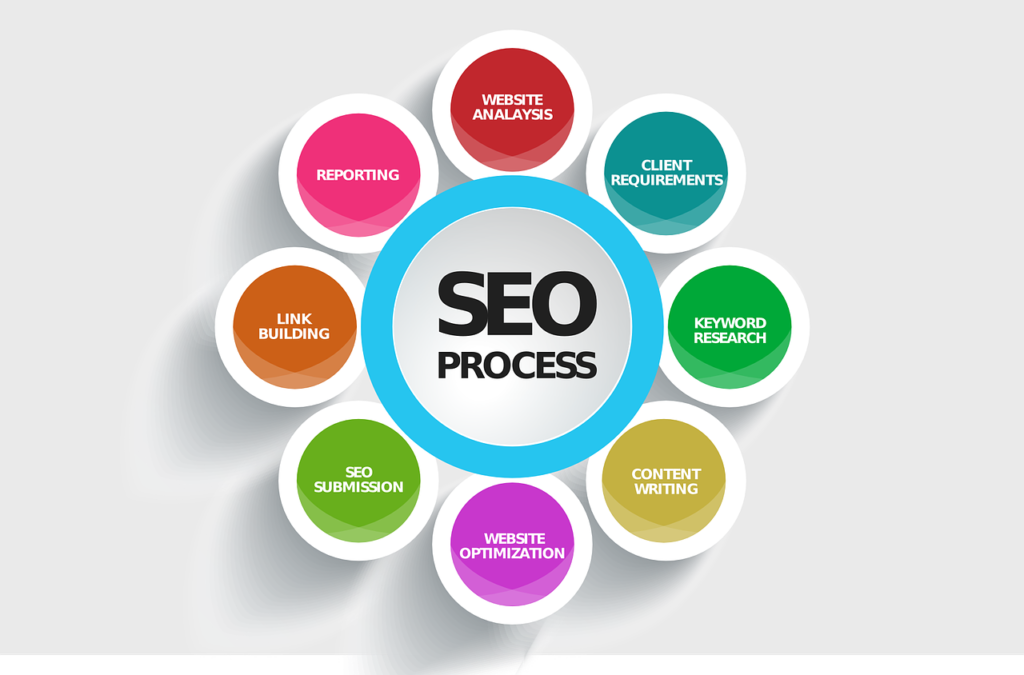Are you tired of your blog languishing in obscurity, lost among the vast expanse of the internet? If so, it’s time to harness the power of SEO strategies and unlock the untapped potential of your content.
By optimizing your blog for increased traffic and revenue, you can elevate your online presence and reach a wider audience. But where do you begin?
In this discussion, we will explore the key strategies and techniques that will help you climb the ranks of search engine results pages, attract more visitors, and ultimately, boost your bottom line.
So, fasten your seatbelts and get ready to embark on a journey towards digital success.
Understanding the Basics of SEO Strategies
To optimize your blog for increased traffic and revenue, it’s essential to understand the basics of SEO. SEO strategies for local businesses play a crucial role in attracting potential customers within the vicinity.
By incorporating localized keywords and optimizing your website for local search, you can increase your visibility in local search engine results. This means that when people search for products or services in their area, your website will be more likely to appear in the search results.
Another important aspect of SEO strategies is mobile optimization. With the increasing use of mobile devices, having a mobile-friendly website has become imperative for SEO success.
Google and other search engines prioritize mobile-friendly websites in their rankings, as they provide a better user experience for mobile users. Therefore, it’s important to ensure that your website is responsive, loads quickly on mobile devices, and has a mobile-friendly design.

Conducting Keyword Research
When it comes to optimizing your blog for increased traffic and revenue, effective keyword selection is crucial.
By analyzing search trends, you can identify popular keywords that align with your blog’s content.
Additionally, targeting long-tail keywords can help you attract more specific and qualified traffic to your blog.
Effective Keyword Selection
Choose the most relevant keywords to optimize your blog for increased traffic and revenue. Conducting keyword research is crucial for effective keyword selection.
By understanding the importance of keyword relevance and implementing strategies for keyword placement, you can attract more visitors to your blog and ultimately boost your revenue.
To help you in this process, here is a table highlighting three key aspects of effective keyword selection:
| Aspect | Description |
|---|---|
| Search Volume | The average number of searches a keyword receives per month. |
| Keyword Difficulty | An estimate of how hard it is to rank for a keyword based on competition. |
| Relevance to Your Blog | How closely does the keyword align with the content and purpose of your blog? |
Analyzing Search Trends
Understanding the search trends is essential for effective keyword research and optimizing your blog for increased traffic and revenue. Identifying emerging search trends allows you to stay ahead of the competition and create relevant content that resonates with your audience.
By leveraging social media for SEO success, you can tap into valuable insights and discover what topics are currently popular and being searched for.
Social media platforms provide a wealth of information about the interests and behaviors of your target audience, enabling you to tailor your content to meet their needs.
Additionally, monitoring social media conversations and engagements can help you identify new keywords or variations of existing ones that can boost your blog’s visibility in search results.
Targeting Long-Tail Keywords
To effectively target long-tail keywords and conduct keyword research for your blog, it’s important to understand the interests and behaviors of your target audience.
By doing so, you can create content that aligns with their needs and preferences, increasing the chances of attracting organic traffic.
Here are four key steps to help you optimize your long-tail keyword strategy and improve the relevance of your content:
- Identify your target audience: Understand who your ideal readers are and what they’re searching for. This will help you tailor your content to their specific needs.
- Use keyword research tools: Utilize tools like Google Keyword Planner, SEMrush, or Ahrefs to find long-tail keywords that are relevant to your niche and have a good search volume.
- Focus on keyword relevance: Ensure that the long-tail keywords you choose accurately reflect the content of your blog post. This will help search engines understand what your content is about and rank it accordingly.
- Monitor and refine: Continuously monitor the performance of your keywords and make adjustments as necessary. Keep track of which keywords are driving the most traffic and conversions, and optimize your content accordingly.
Optimizing On-Page Elements
Optimizing on-page elements can significantly enhance your blog’s visibility, attract visitors, and boost revenue potential. Two crucial elements to focus on are improving website speed and optimizing meta tags.
Improving website speed is essential because fast-loading pages provide a better user experience, leading to higher engagement and lower bounce rates.
Slow-loading websites frustrate visitors and can negatively impact your search engine rankings. To improve website speed, consider compressing images, minimizing HTTP requests, and enabling browser caching.
Meta tags are HTML elements that provide information about your web page to search engines. Optimizing meta tags can help search engines understand the content and relevance of your blog.
The two primary meta tags to optimize are the title tag and meta description. The title tag should be concise, descriptive, and contain relevant keywords. The meta description should provide a compelling summary of your blog post, enticing users to click through to your site.
Here’s a visual representation of these on-page optimization elements:
| On-Page Elements | Importance | Actions to Take |
|---|---|---|
| Improving website speed | High | Compress images, minimize HTTP requests, enable caching |
| Optimizing meta tags | Medium | Optimize title tag with keywords, create compelling meta descriptions |

Building High-Quality Backlinks
To further enhance your blog’s visibility and increase traffic, it’s crucial to focus on building high-quality backlinks. Backlinks are links that are directed from other websites to your blog.
They’re a key component of search engine optimization (SEO) and play a vital role in improving your blog’s rankings on search engine result pages.
Here are some strategies to help you build high-quality backlinks:
- Identifying authoritative websites: Look for websites that are considered authoritative in your niche or industry. These websites have a strong online presence and are trusted by users and search engines alike. Getting backlinks from such websites can greatly boost your blog’s credibility and visibility.
- Developing link-building strategies: Create a plan to acquire backlinks from authoritative websites. This can involve contacting website owners or bloggers in your industry and offering to write guest posts or collaborate on content. You can also participate in online communities and forums to build relationships and gain backlinks.
- Creating valuable and shareable content: Focus on creating high-quality content that provides value to your target audience. When your content is informative, engaging, and shareable, other websites are more likely to link back to it.
- Monitoring and analyzing your backlinks: Regularly monitor your backlinks to ensure they’re still active and relevant. Use tools like Google Analytics to track the impact of your backlinks on your blog’s traffic and rankings.
Creating Engaging and Shareable Content
Creating content that captivates and compels your audience is key to building engagement and encouraging sharing. To create such content, it’s important to understand what resonates with your target audience and tailor your messaging accordingly.
One effective way to do this is by incorporating the following elements into your content:
- Relevance: Ensure that your content is aligned with your audience’s interests and needs. Conduct thorough research to identify trending topics and keywords that are relevant to your industry.
- Visual Appeal: Use appealing visuals such as images, infographics, and videos to enhance the visual appeal of your content. Visuals not only grab attention but also make the content more shareable on social media platforms.
- Emotional Connection: Create content that evokes emotions such as joy, surprise, or empathy. Emotional content tends to be more memorable and shareable as it resonates with the audience on a deeper level.
By incorporating these elements into your content, you can increase its shareability and engagement.
However, creating great content is just the first step. To ensure maximum reach, it’s important to promote your content through various channels, including social media platforms.
Engage with your audience on social media by responding to comments, asking questions, and sharing valuable insights. This won’t only increase social media engagement but also encourage your audience to share your content with their networks.
Monitoring and Analyzing SEO Performance
Monitoring and analyzing your SEO metrics is a vital aspect of boosting your blog’s performance and enhancing its visibility. By tracking progress and measuring success, you can gain valuable insights into the effectiveness of your SEO strategies and make data-driven decisions to improve your blog’s ranking and traffic.
Here are four key steps to help you monitor and analyze your SEO performance:
- Set up an analytics tool: Use a reliable analytics tool like Google Analytics to track important metrics such as organic traffic, bounce rate, and conversion rates. This will provide you with valuable data to assess the performance of your SEO efforts.
- Monitor keyword rankings: Regularly check your blog’s ranking for target keywords to see how well your content is performing in search engine results. If you notice a decline in rankings, it may be an indication that you need to optimize your content or adjust your SEO strategy.
- Analyze inbound links: Keep an eye on the number and quality of websites linking back to your blog. High-quality inbound links can significantly improve your search engine rankings. Identify opportunities to build new links and remove any toxic or low-quality links that could harm your SEO performance.
- Track engagement metrics: Pay attention to metrics like page views, time on the page, and social shares to understand how engaged your audience is with your content. High engagement indicates that your SEO efforts are driving relevant traffic and resonating with your audience.
Frequently Asked Questions
How Long Does It Typically Take to See the Results of SEO Efforts?
You can typically start seeing the results of your SEO efforts within a few months. It’s important to do keyword research and optimize your pages to improve your chances of success.
Can I Optimize My Blog for Multiple Keywords?
Yes, you can optimize your blog for multiple keywords. By incorporating effective keyword strategies and optimizing your blog content, you can increase your chances of ranking for multiple relevant search terms.
Is It Necessary to Hire an SEO Agency or Can I Do It Myself?
It’s up to you whether to hire an SEO agency or do it yourself. There are pros and cons to both options. To effectively optimize your blog for SEO, follow these steps.
How Do Search Engines Determine the Relevance and Quality of Backlinks?
To understand link-building strategies, search engines evaluate the relevance and quality of backlinks. They consider factors like the authority of the linking site, anchor text, and the impact of social media on backlink quality.
What Are Some Common Mistakes to Avoid When Optimizing Blog Content for SEO Strategies?
When optimizing your blog content for SEO, it’s important to avoid common mistakes. Follow best practices to maximize your chances of success.
Conclusion
In conclusion, by implementing effective SEO strategies, you can significantly increase traffic and revenue for your blog.
Understanding the basics of SEO strategies, conducting keyword research, optimizing on-page elements, building high-quality backlinks, creating engaging and shareable content, and monitoring and analyzing SEO performance are all crucial steps in achieving success.
So, put in the effort to optimize your blog and enjoy the benefits of increased visibility, higher traffic, and improved revenue.





